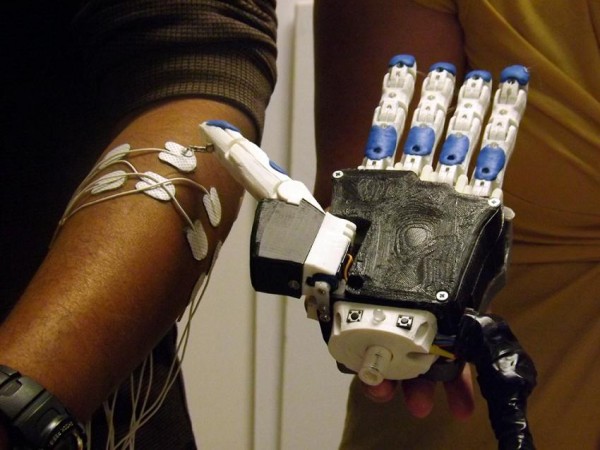Illinois Students 3D Print Smarter and Cheaper Prosthetic Hands
| Marc Maligalig | | Oct 30, 2014 06:12 AM EDT |
(Photo : Mike Koon, University of Illinois) The 3D-printed prosthetic hand can be programmed to recognize a hand at-rest, open-faced, closed (tool grip), a three-finger grip, and fine pinch.
Students from the University of Illinois at Urbana Champaign have developed one of the first 3D-printed prosthetic hands with the ability to recognize patterns.
A machine-learning algorithm lets the hand do more than just close and open. The hand can learn other possible positions for more functionality.
Like Us on Facebook
Just as importantly, it's relatively cheap to make at only US$270. The common myoelectric prosthetic limb retails for US$30,000 to US$40,000, making the 3D-printed prosthetic 111 times cheaper than the cheapest limb in the market with the same capabilities.
"Using the machine-learning algorithm based off the signals it picks up from the muscles, it can figure out which of these grips he is actually doing," explained team leader Aadeel Akhtar, an MD/PhD candidate in neuroscience from the College of Medicine at Illinois.
"The microcontroller with the machine-learning algorithm will then replicate the grip he's trying to make. Based on those signals, it sends commands to motor drivers, which churn the motor and make the hand move."
While the EMG board currently being used for the present prototype is just as big as a common audio mixing board, advances in technology will gradually shrink it to a size that can fit inside the device.
The team has encoded five mathematical models of actions: at-rest, a fine pinch, open-faced, closed and a three-finger grasp.
Training a user to use the prosthetic limb only takes a minute or two and requires the patient to do all five gestures.
Akhtar and Mary Nguyen, a master's student in aerospace engineering, traveled to South America in August and put their most recent device, an open-source dexterous artificial hand, through a trial by fire with an Ecuadorian man.
"The goal of the trip was to get it to work with a patient," Akhtar said. "Although it took some debugging, we were successful."
Tags3D Printing, 3D-Printed prosthetic hand, Prostheses, Prosthesis, Amputee, Robotics
©2015 Chinatopix All rights reserved. Do not reproduce without permission
EDITOR'S PICKS
-

Did the Trump administration just announce plans for a trade war with ‘hostile’ China and Russia?
-

US Senate passes Taiwan travel bill slammed by China
-

As Yan Sihong’s family grieves, here are other Chinese students who went missing abroad. Some have never been found
-

Beijing blasts Western critics who ‘smear China’ with the term sharp power
-

China Envoy Seeks to Defuse Tensions With U.S. as a Trade War Brews
-

Singapore's Deputy PM Provides Bitcoin Vote of Confidence Amid China's Blanket Bans
-

China warns investors over risks in overseas virtual currency trading
-

Chinese government most trustworthy: survey
-

Kashima Antlers On Course For Back-To-Back Titles
MOST POPULAR
LATEST NEWS
Zhou Yongkang: China's Former Security Chief Sentenced to Life in Prison

China's former Chief of the Ministry of Public Security, Zhou Yongkang, has been given a life sentence after he was found guilty of abusing his office, bribery and deliberately ... Full Article
TRENDING STORY

China Pork Prices Expected to Stabilize As The Supplies Recover

Elephone P9000 Smartphone is now on Sale on Amazon India

There's a Big Chance Cliffhangers Won't Still Be Resolved When Grey's Anatomy Season 13 Returns

Supreme Court Ruled on Samsung vs Apple Dispute for Patent Infringement

Microsoft Surface Pro 5 Rumors and Release Date: What is the Latest?










